Key Insights
- POL officially launched on September 4, 2024, as the native gas and staking token for the Polygon PoS network.
- Polymarket, a Polygon PoS-based application, has emerged as one of 2024’s most successful crypto platforms. The platform has seen over $3 billion in bets related to the election, adding over 140,000 new accounts in October alone.
- Polygon PoS concluded Q3 2024 with a stablecoin market capitalization of $1.9 billion, reflecting a 10% QoQ increase and a 30% rise over the past six months. USDC supply on Polygon increased 42% QoQ, increasing from $618 million to $880 million.
- Polygon Labs announced a $5 million investment in Verifiable Processing Units (VPUs) from Fabric to support Polygon zkEVM, the AggLayer, and Polygon CDK initiatives. These VPUs will enhance zk-proof efficiency, powering the Plonky2 and Plonky3 systems.
- A 1 billion POL Community Grants Program (CGP) was initiated in Q2 2024 to support the Polygon ecosystem. Over the next decade, CGP will distribute 100 million POL tokens annually, managed by an independent Community Treasury Board.
Primer
Polygon Labs is a zero-knowledge (ZK) focused software company building and developing a network of aggregated blockchains via the AggLayer. As public infrastructure, the AggLayer will bring together user bases and liquidity for any connected chain and leverage Ethereum as a settlement layer. Polygon Labs has also contributed to the core development of several widely adopted scaling protocols and tools for launching blockchains, including the Polygon Proof-of-Stake (PoS) network, Polygon zkEVM, and Polygon Miden. Polygon Chain Development Kit (CDK) is a collection of open-source software components that makes it easy for developers to design and launch ZK-powered L2s on Ethereum and connect to the AggLayer.
The core vision of an aggregated network is to enable shared state and unified liquidity through the integration of ZK technology for a horizontally scalable web of chains that looks and feels more like the internet. As a part of the roadmap, there is a proposal to connect the Polygon PoS network to the AggLayer as the first phase in upgrading Polygon PoS to a zkEVM Validium network. Community and core developer discussions about significant updates to protocol architecture, tokenomics, and governance remain ongoing.
Key Metrics
Polygon Technical Developments
Introduction
Over the past year, Polygon has undergone a significant number of technical developments. These updates aim to address inherent scaling challenges in crypto by synthesizing the two most important approaches to blockchain design: modular and integrated designs. While modularity allows new sovereign chains to be spun up and designed to any specification, it often results in fragmented liquidity and an underwhelming user experience. On the other hand, integrated chains face scaling limits.
Core developers at Polygon Labs have proposed a third way: an aggregated approach to blockchain scaling. They assert that a single chain does not have the capacity to handle any future state of Web3 that approaches the size of the internet; only an aggregated network will suffice.
The AggLayer
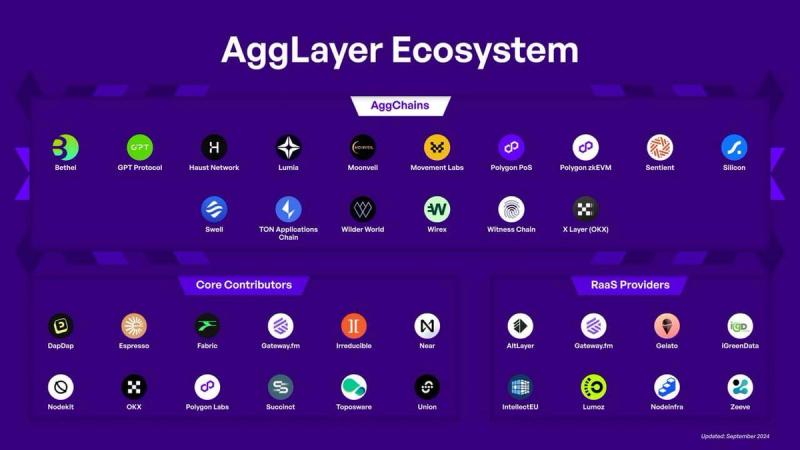
In January 2024, Polygon Labs introduced the AggLayer, a neutral service designed to unify ZK chains by aggregating proofs, verifying chain states, and settling to Ethereum. This enables low-latency coordination and safe interoperability, allowing developers to focus on project design without needing to bootstrap liquidity.
In Q2 2024, SP1, a zkVM built with Polygon Plonky3, was announced to generate pessimistic proofs, enhancing cross-chain security by ensuring no chain withdraws more than it deposits on the unified bridge. In July 2024, Polygon Labs announced Plonky3 as production-ready and open-source. Whereas Plonky2 was a single proving system focused on lightning fast recursion by optimizing for hardware, Polygon Plonky3 is an open source toolkit that empowers ZK developers to build their own zkVMs or zkEVMs.
In Q3 2024, Movement Labs announced that it would be integrating MoveVM-based Layer-2 chains with AggLayer using a state-minimized approach and Move Stack, supporting parallel execution and improving efficiency. Movement Labs’ testnet has $160 million in TVL. Additionally, Polygon Labs collaborated with Fabric to introduce Verifiable Processing Units (VPUs), optimizing zero-knowledge cryptography and enhancing efficiency for ZK-powered protocols like the AggLayer and zkEVM. The $5 million investment by Polygon Labs aims to boost transaction speed, security, and cost-efficiency.
These developments are in addition to the Q2 2024 progress, which included Union’s integration with AggLayer to enable seamless crosschain transactions with IBC-enabled chains. Espresso Systems also announced a collaboration to improve transaction efficiency and user experience across multiple chains, coordinating rollups before settling on Ethereum.
Polygon CDK
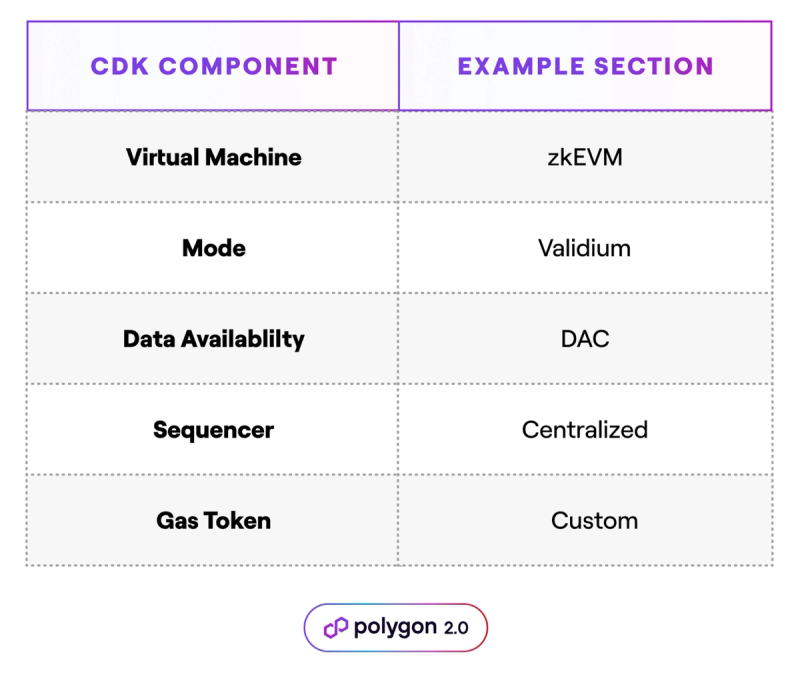
In Q3 2023, Polygon Labs released the Polygon Chain Development Kit (CDK), an open-source development framework for launching ZK L2s and transitioning existing EVM L1s to L2s. Polygon CDK focuses on customizability and ZK technology, with future functionality planned to make connecting Polygon CDK chains to the AggLayer seamless.
Numerous notable teams have announced CDK chains, including OKX, Ronin, Immutable, Moonveil, Fox, Witness Chain, Silicon, Manta, Hypr Network, FlipKart, Libre, Arianee, Gnosis Pay, Ton Applications Chain (TAC), and WireX, among many others.
In Q3 2024, Polygon Labs and Irreducible began collaborating on the development of a Binius-based zkVM, leveraging binary fields to improve computational efficiency in zero-knowledge cryptography. This zkVM aims to enhance interoperability and security across both EVM and non-EVM chains within the AggLayer protocol. The zkVM is expected to be ready for testing by the end of 2024.
Also in Q3 2024, TAC (Ton Applications Chain) announced the development of a new ZK Layer-2 chain built on the TON blockchain using the Polygon CDK. This open-source deployment will enable the TON ecosystem to connect to the AggLayer and create EVM compatibility for Telegram applications.
Polygon Miden
Polygon Miden is an upcoming ZK L2 utilizing the Rust-based Miden Virtual Machine instead of the Ethereum Virtual Machine. It aims for high-throughput applications using zero-knowledge proofs (ZKPs), emphasizing sovereignty and client-side proving for scalability. Additionally, Polygon Labs introduced Polylang, a TypeScript-based language for the Miden VM.
In July and September 2024, Polygon Miden launched Alpha Testnet versions v3 and v4, respectively, introducing several features to enhance the developer experience, such as sub-second order updates, transaction IDs in blocks, a no-std client for browser use, a Rust compiler for Miden Assembly, a block explorer, multi-note transaction support, and a Miden Web client. These updates boost scalability, composability, user interactions, and smart contract capabilities, paving the way for innovative applications on Polygon Miden.
In August 2024, Polygon Miden integrated QED Protocol’s WebGPU API to boost transaction execution, improving ZK proof generation speed by a factor of ten. This collaboration enhances client-side proving, allowing for faster decentralized app execution and reducing transaction fee variance.
Multiple teams have committed to developing on Miden, including Rize Labs, which announced an online poker game; Keom, which is developing a decentralized order book exchange; and Composability Labs, which is building Spark, an on-chain central limit order book. Spark leverages ZKPs to minimize state bloat, allowing for efficient on-chain transactions and providing a professional-grade trading experience in DeFi.
Polygon PoS
In Q1 2024, Polygon PoS underwent the Napoli upgrade to enhance performance and expand features, including support for RIP-7212, improved parallel execution, and new opcodes from Ethereum’s Cancun upgrade. The Napoli upgrade brings significant technical advancements, such as better account abstraction and more efficient parallel transaction execution.
In September 2024, Polygon PoS underwent the Ahmedabad upgrade. This upgrade allows developers to deploy more complex contracts with an increased code size limit (24KB to 32KB) and includes a token symbol change from MATIC to POL, along with a mechanism to replay failed state syncs.
Polygon zkEVM
During Q3 2024, the Polygon zkEVM underwent two significant updates. In August, Polygon Labs announced an update to the Polygon zkEVM Mainnet Beta network, adopting the cdk-erigon as the official RPC Node. This adoption is meaningful because the cdk-erigon RPC provides 150x faster synchronization speed for chains built with Polygon CDK. Built by Gateway—the team behind the widely used Ethereum Erigon client—the cdk-erigon sequencer is optimized to create a more stable, higher-throughput network.
In September, the Eggfruit upgrade went live, introducing the cdk-erigon sequencer. This new sequencer brings more stability to the beta version of Polygon zkEVM, allowing it to handle enormous influxes of traffic without issues. The upgrade also doubled the zkCounters, which provide a ceiling on the amount of computation that can be used to generate a proof. With twice as many zkCounters, the Eggfruit upgrade makes more complex transactions possible. Following this upgrade, all infrastructure providers will need to begin running the cdk-erigon RPC Node, as the legacy RPC Node is being deprecated.
Financial and Network Overview
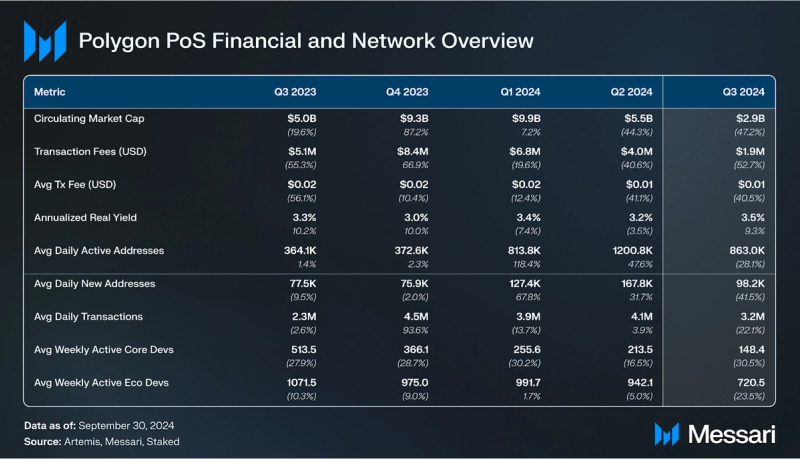
Market Capitalization

The last year has seen dramatic swings in the valuation of POL (formerly MATIC). Between Q3 2023 and Q1 2024, POL’s market capitalization increased 100%, rising from $5 billion to $10 billion. However, in Q2 and Q3 2024, POL retraced along with the broader market, ending Q3 2024 at $2.9 billion—a decline of 47% QoQ. This significant drop in market capitalization is partly attributed to the ongoing transition from MATIC to POL, during which the market cap is divided between the two tokens. As of the end of Q3 2024, only 77% of the supply has transitioned to POL, with the remaining 23% still in MATIC. POL’s market cap ranking remains the largest Ethereum Layer-2 by market capitalization.
Transaction Fees
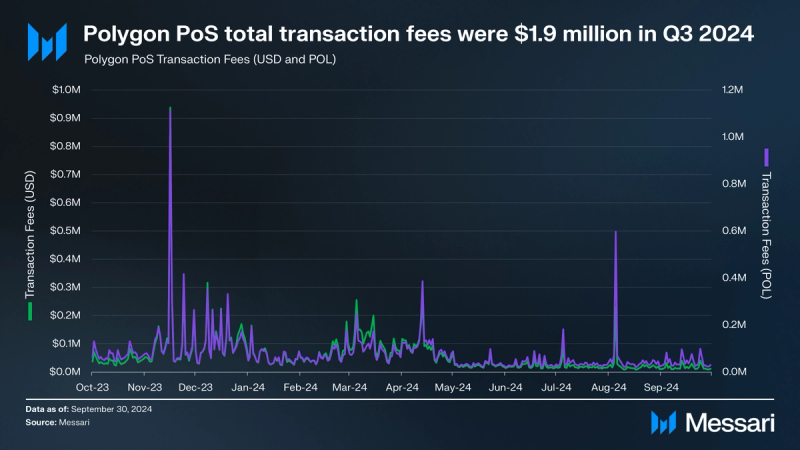
In Q1 2024, EIP-4844 was enacted on Polygon PoS mainnet, introducing blobs and significantly changing the Polygon cost structure. EIP-4844 and blobs result in cheaper posting costs to the L1, which lowers users’ average transaction fees. Consequently, the average transaction fee has fallen significantly, down to $0.006 during Q3 2024.
In Q3 2024, Polygon transactions fell by 22% QoQ. As a result, total transaction fees also declined, falling by 53% QoQ to $1.9 million. This drop was driven by both the reduction in the number of transactions and the lower average transaction fee.
Supply
As part of the Polygon upgrades, POL officially went live on September 4, 2024, and is now the native gas and staking token for the Polygon PoS network. While POL replaces MATIC for these purposes, there is no set deadline for the remaining circulating MATIC tokens to be upgraded to POL. In the first phase of the transition, as per governance decisions, POL is being used as the gas and staking token in Polygon PoS. In subsequent phases, POL will play a pivotal role in the AggLayer. It will enable holders to contribute to network security across various chains via a native re-staking protocol, earning rewards for diverse services. These services will range from basic transaction validations to more advanced tasks like generating ZK-validity proofs. Each protocol in the Polygon ecosystem can offer customized roles and rewards for validators.
POL adopts an inflationary model with a yearly emission rate of 2%, which is divided equally between validator rewards and the Community Treasury. This model aims to incentivize validator participation and fund a community-governed treasury for network growth and development.
Activity

After a year straight of increasing active addresses, Polygon PoS saw a decline in active addresses during Q3 2024. The daily active addresses fell to 863,000, representing a 28% decrease QoQ. Similarly, daily new addresses dropped to 98,200, a 42% decline QoQ, and daily transactions decreased to 3.2 million, down 22% QoQ. The majority of this decrease can be attributed to a reduction in gaming activity, which had previously been a major driver of user engagement on the network. Despite the slowdown, all three metrics were still up greater than 20% YoY.
Sectors
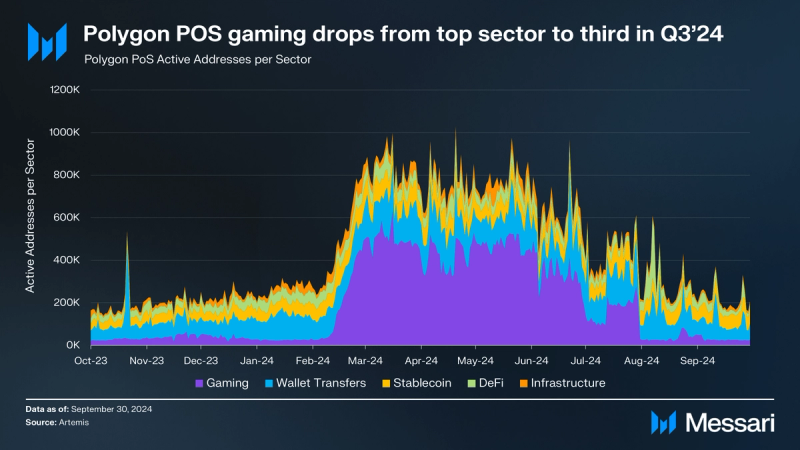
Gaming was the dominant sector on Polygon PoS for the first half of the year. Over 95% of this gaming activity came from MATR1X, a Web3 entertainment platform that integrates various gaming and NFT elements within a metaverse setting. However, in Q3 2024, MATR1X activity fell significantly as the platform prepared for the launch of new products and versions. This involved smart contract migrations and ongoing development, which temporarily reduced user engagement. Consequently, Polygon PoS’s topline user metrics declined along with the decreased activity from MATR1X.
Outside of gaming, most sectors saw increased activity in Q3 2024. Average daily stablecoin users increased 10% QoQ to 75,000, and DeFi activity increased 19% QoQ to 55,000 daily active users.
Arguably, the biggest winner in Q3 2024 and most of the past year in crypto has been Polymarket. Polymarket is the Polygon-based predictions market which has gained global recognition as the leading US elections political betting market. The growth of Polymarket has been incredible. With $1.4 billion bet on the US presidential elections, it is on track for over $2 billion in volume and 140,000 new accounts in October alone.
The success of DePIN is also notable. DIMO was spotlighted as a DePIN protocol aiming to transform the auto industry by giving drivers control over their vehicle data and allowing them to earn rewards.
The tokenization of real-world assets (RWAs) emerged as a trend in Q3 2024. Courtyard, a platform that tokenizes real-world objects—primarily collectible cards but with plans for more—saw a significant increase in activity quarter-over-quarter. The number of Courtyard holders has grown to over 7,000, and total transactions are approaching 800,000. By leveraging the Polygon network, Courtyard enables users to own and trade NFTs that are backed by physical assets securely stored and insured.
Development
Polygon has consistently prioritized its developer ecosystem. According to Electric Capital, Polygon ranked as the third largest developer ecosystem in crypto as of July 2024, with 2,900 total developers, of which 830 were full-time.
Developments throughout 2024 have included Polygon Labs achieving ISO 27001 certification, P2 Ventures committing $50 million via Hadron FC to support startup founders, and the launch of a 1 billion POL Community Grants Program. The CGP program allocates 1B POL over 10 years, with 100M a year, and starting with 35 million POL in Season 01. The program, overseen by the Community Treasury Board, supports long-term projects on Polygon.
Developer activity continued in Q3 2024, with Backpack’s Wallet adding full support for Polygon, enhancing the network’s accessibility for users. Additionally, ZetaChain integrated with Polygon.
Governance
Polygon Governance 2.0 introduces three main governance pillars for Polygon. Each pillar of governance will have its own unique governance framework, aiming to create scalable and efficient governance mechanisms.
- Protocol Governance: Facilitated by the Polygon Improvement Proposal (PIP) framework, providing a platform for proposing upgrades to Polygon protocols.
- System Smart Contracts Governance: Addresses upgrades of protocol components implemented as smart contracts. The Protocol Council, governed by the community, will be responsible for these upgrades.
- Community Treasury Governance: Establishes a self-sustainable ecosystem fund, the Community Treasury, to support public goods and ecosystem projects. The governance process involves two phases, starting with an independent Community Treasury Board and evolving into community-driven decision-making.
In Q2 2024, the Governance Hub was announced with coordination by Aragon, enabling community-driven protocol and smart contract upgrades. It will be a full-stack governance solution and user interface for the community focusing on two of Polygon Governance’s three pillars: Protocol Governance and System Smart Contracts Governance. Users can propose and vote on PIPs, enhancing transparency and participation.
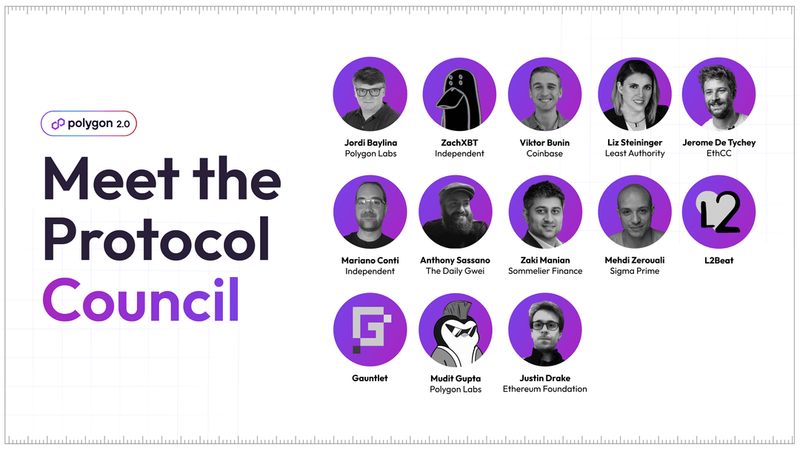
In Q4 2022, PIP-29 proposed the introduction of the Polygon Protocol Council, which was adopted by the community. The council is responsible for conducting both regular and emergency upgrades to system smart contracts, specifically components of Polygon protocols that are implemented as smart contracts on Ethereum. The Protocol Council consists of 13 publicly named members.
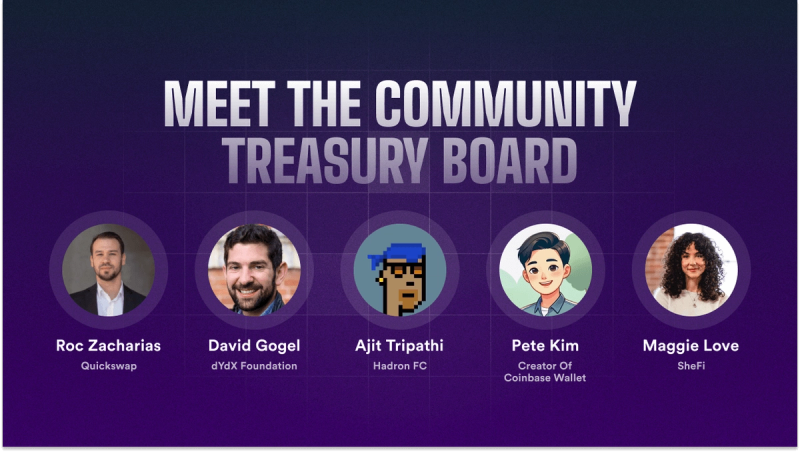
In Q1 2024, the Polygon Community Treasury Board (CTB) and Governance Framework were announced, aiming to enhance the ecosystem through strategic capital allocation. This framework includes direct and Grant Allocator funding tracks overseen by the CTB, responsible for funding decisions, application reviews, and post-cycle reporting.
Michael Blank, chief operating officer at Polygon Labs since March 2022, announced he is stepping down. Polygon Labs also announced that Sandeep Nailwal, co-founder and executive chairman of Polygon Labs, is expanding his role to serve as Chief Business Officer.
Ecosystem Overview
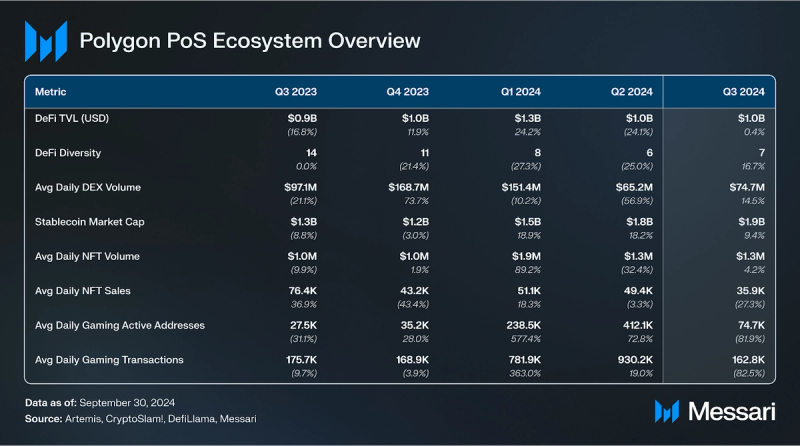
DeFi

Polygon PoS DeFi Total Value Locked (TVL) ended Q3 2024 at $1.0 billion, essentially flat QoQ. Polygon fell from being the eighth largest network by TVL to the tenth.
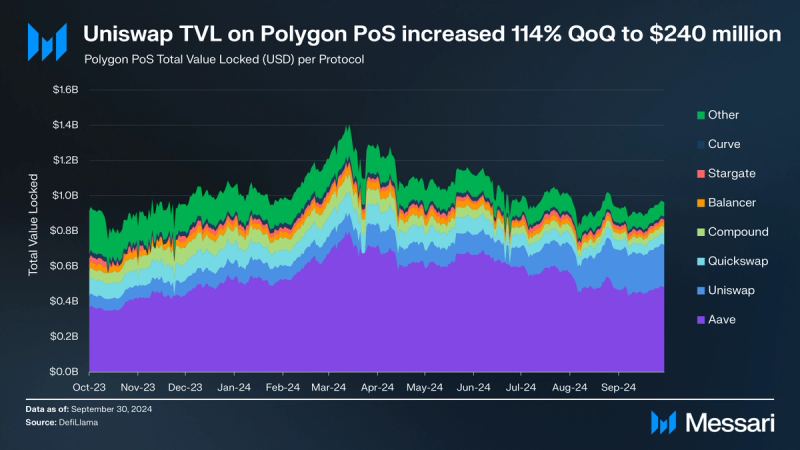
Aave continued to be the leading protocol by TVL on Polygon PoS with $482 million in TVL (-19% QoQ). However, the gap has closed, with Uniswap ending Q3 2024 with a TVL of $240 million (+114% QoQ). The next largest protocols by TVL were Quickswap with $60 million (-17% QoQ), Compound with $42 million (+3% QoQ), Balancer with $22 million (-22% QoQ), Stargate with $19 million (+57% QoQ), and Curve with $17 million (-15% QoQ). The total TVL of protocols outside of the top seven was $83 million, which was flat QoQ.

Polygon PoS’s stablecoin supply continued to increase in Q3 2024. Polygon PoS ended Q3 2024 with a total stablecoin market capitalization of $1.9 billion, which was up 10% QoQ and up 30% over the past six months.
There was dispersion in the growth among stablecoins. USDT had been growing its market share, but after the migration to native USDC in March 2024, USDC has been growing. This growth was expedited in Q3 2024 as the total USDC supply on Polygon increased 42% QoQ from $618 million to $880 million (+42% QoQ), while the USDT supply fell 2% QoQ, ending the quarter at $886 million. DAI gave back the supply gains it had seen last quarter and ended Q3 2024 at $137 million (-27% QoQ). Polygon remained the eighth-largest chain by stablecoin supply at the end of Q3 2024.
During Q3 2024, Polygon integrated the Bridged USDC Standard with its Chain Development Kit. This integration ensures that any chain developed with Polygon CDK will support an upgradeable version of bridged USDC, simplifying future transitions to native USDC without requiring code changes.
NFTs
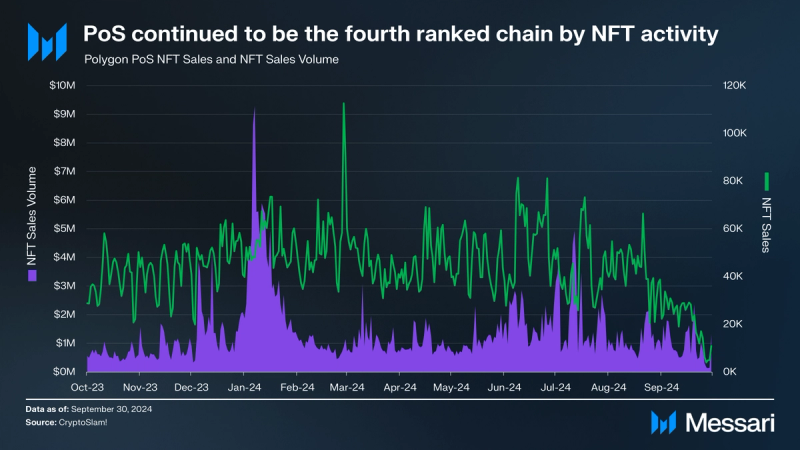
Polygon PoS NFT activity persisted in Q3 2024. The average daily NFT volume was $1.3 million, reflecting a 4% increase QoQ, while the average daily NFT sales fell to 36,000, marking a 27% decrease. Polygon remained the fourth largest chain by NFT activity, only trailing Ethereum, Bitcoin, and Solana.
NFT activity continued to have a healthy distribution, with the top collections consisting of Courtyard, Mining Pass, and MATR1X Fire Weapon, all of which had greater than $3 million in sales in September.
During Q3, following a failed assassination attempt on the former U.S. President Donald Trump, the floor price of Trump Digital Trading Card NFTs soared, reaching $502 before settling around $410. The NFTs, which feature Trump in various scenarios, saw a significant increase in trading volume due to market interest and speculation. Additionally, DraftKings terminated its Reignmakers NFT-powered fantasy sports experience amid a class action lawsuit in Massachusetts federal court, which alleged that the Reignmakers NFTs were unregistered securities.
Gaming
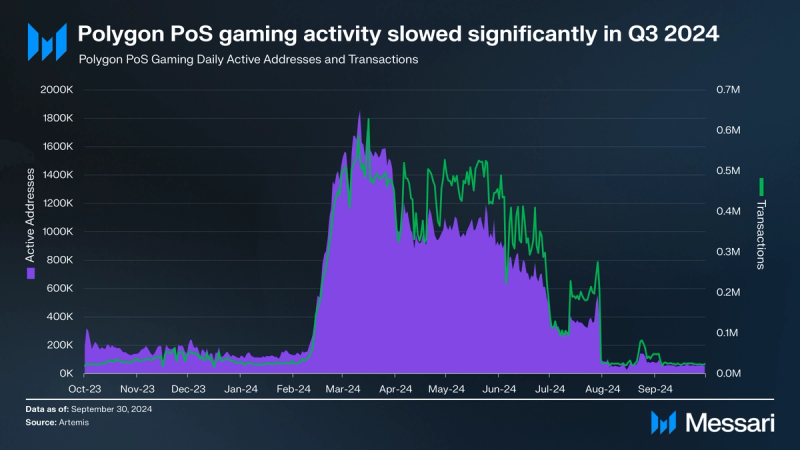
Gaming has been the largest and fastest-growing sector on Polygon through 2024. However, in Q3 2024, gaming activity on Polygon PoS experienced a decline, primarily driven by MATR1X FIRE slowing down. The daily gaming active addresses decreased to 75,000 (-82% QoQ), while daily gaming transactions fell to 163,000 (-83% QoQ).
Despite the decrease on Polygon PoS, the overall gaming ecosystem on Polygon remains strong and continues to expand. Polygon’s efforts and technology support not just the PoS chain but also other significant gaming platforms. For instance, Immutable is building a zkEVM using the Polygon CDK, and during Q1 2024, in collaboration with King River Capital and Polygon Labs, launched the $100 million Inevitable Games Fund focused on the crypto gaming ecosystem. Additionally, Ronin is deploying a chain using the Polygon CDK.
During Q3 2024, Square Enix backed Soccerverse, a blockchain-based football MMO, by leading a $3.1 million fundraising round. Soccerverse operates on Polygon and aims to merge traditional gaming with Web3 features, providing a unique and engaging experience for football fans.
Therefore, while gaming activity on Polygon PoS might be down, the overall Polygon ecosystem gaming remains robust.
Institutional
Over the last six months, Polygon has had a number of institutional collaborations, including:
- Libre announced the launch of a dedicated chain powered by Polygon CDK, tailored for institutional Web3 infrastructure for alternative investments. This initiative allows regulated entities to issue tokenized assets, with Brevan Howard and Hamilton Lane as the inaugural partners.
- Fox Corporation unveiled Verify, an open-source protocol initially launched on Polygon PoS, aimed at enabling publishers to register and authenticate the origin of media content, particularly in combating the proliferation of AI-generated media. Fox has since announced plans to upgrade Verify to a Layer 2 built with Polygon CDK, with TIME as the first publishing partner.
- Polygon Labs became a member of the Tokenized Asset Coalition (TAC), an initiative focused on leveraging public blockchains, asset tokenization, and institutional DeFi to transform capital formation and management onchain.
- Ernst & Young (EY) launched an enterprise contract management service utilizing Polygon PoS to facilitate secure, private contracts on a public blockchain using zero-knowledge proofs.
- Franklin Templeton enabled peer-to-peer transfers for its $380 million tokenized money market fund on Stellar and Polygon.
- Italy’s Top Banks: Participated in a €25 million digital bond issuance on the Polygon blockchain as part of a European Central Bank (ECB) trial. This initiative, in collaboration with Fireblocks, aims to explore the potential of decentralized finance and tokenized assets within traditional banking frameworks.
- ABN AMRO issued a €5 million digital green bond on Polygon in January 2024, using the ERC-3643 standard.
- Ondo Finance launched a treasury-backed Government Bond Fund on Polygon in July 2024, providing exposure to tokenized U.S. Treasuries and integrating with DeFi platforms like Flux.
- Cofund.ai partnered with Tokeny Solutions in 2024 to tokenize a $10 million hotel in Bali, Indonesia.
- Securitize announced the tokenization of over $100 million worth of venture capital funds on Polygon in January 2024. This initiative included funds from firms like Draper Associates.
- Spiko launched the world’s first fully licensed tokenized Money Market Funds on Ethereum and Polygon PoS, with over $50 million committed and a €4 million pre-seed round led by frst_vc.
- Assetera, an Austria-regulated investment and trading firm, plans to offer tokenized assets on Polygon, utilizing the network to power its secondary market for real-world assets.
Additional Developments
Additional developments related to the broader Polygon ecosystem in Q3 2024 include:
- Farcaster Frames Now Supports Polygon PoS Transactions: Farcaster Frames now supports Polygon PoS transactions, enabling interactive onchain actions directly from Farcaster feeds, such as minting NFTs and participating in events. This integration includes a 500k POL grants program aimed at fostering innovation among builders using Farcaster Frames. The grants program is part of the Community Grants Program powered by Gitcoin which ended October fourth.
- Secret’s Confidential Computing Layer Now Integrated with Polygon PoS: Secret’s Confidential Computing Layer is now integrated with Polygon PoS, providing the Polygon community with decentralized confidential computing (DeCC) tooling, documentation, and support.
- Sentient Raises $85 Million Seed Round to Develop Decentralized AI Platform Built on Polygon: Sentient Labs, co-founded by Sandeep Nailwal of Polygon, raised $85 million in seed funding, co-led by Peter Thiel’s Founders Fund, Pantera Capital, and Framework Ventures. The funding will develop an open-source AI platform integrating blockchain with AI to enable decentralized AI solutions, focusing on creating a community-driven AGI platform.
Closing Summary
Polygon had a strong Q3 2024, marked by accomplishments across its network. POL officially launched on September 4, 2024, becoming the native gas and staking token for the Polygon ecosystem. To bolster its scaling initiatives, Polygon Labs announced a $5 million investment in Verifiable Processing Units, aimed at enhancing zkEVM, AggLayer, and Polygon CDK initiatives. These VPUs will play a crucial role in boosting zk-proof efficiency and powering systems like Plonky2 and Plonky3. Additionally, the 1 billion POL Community Grants Program (CGP), launched in Q2 2024, continued to support the Polygon ecosystem.
Polymarket, one of crypto’s most successful applications, saw tremendous growth, with over $3 billion in election-related bets adding over 140,000 new accounts in October. Furthermore, Polygon PoS concluded Q3 2024 with a stablecoin market capitalization of $1.9 billion, reflecting a 10% QoQ increase and a 30% rise over the past six months. USDC supply on Polygon increased by 42% during this quarter, climbing from $618 million to $880 million.
Looking ahead, Polygon remains committed to expanding its network capabilities and advancing technical upgrades. With ongoing investments in zk-proof technology, improvements to developer tools, and the introduction of innovative scaling solutions like AggLayer, the Polygon ecosystem is positioning itself for sustainable, long-term growth.



















